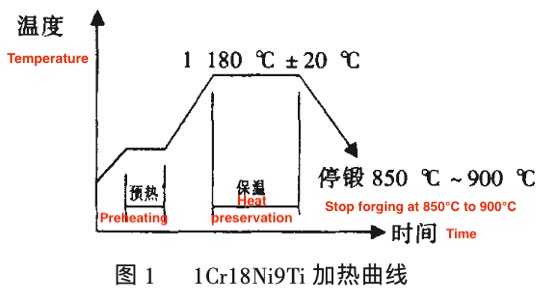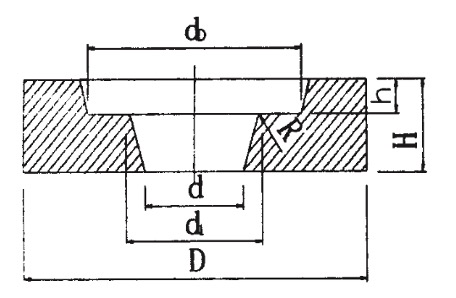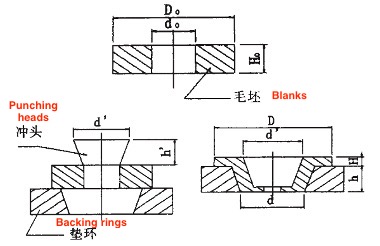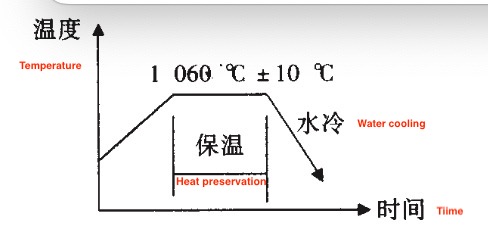The Forging Process of Stainless Steel Flanges
In the production of 38,000t product tankers, all connected pipes and reducing joints require high strength and corrosion resistance, and are all made from stainless steel (1Cr18Ni9Ti). Many connecting flanges must be forged and processed before use. Compared with ordinary carbon steel, stainless steel has many different characteristics, such as low thermal conductivity, narrow forging temperature ranges, good overheating sensitivity, good resistance at high temperatures and low plasticity, which bring many difficulties to the forging of stainless steel. In order to ensure the product’s quality, the forging process of stainless steel flanges must be strictly formulated.
1. Controlling the forging process
1.1 Organizational characteristics
The most used types of stainless steel are austenitic stainless steel and martensitic stainless steel. The 1Cr18Ni9Ti used in the flange here is austenitic stainless steel. This steel has no allotropic transformation and can obtain a uniform austenite structure when heated to about 1000°C. The austenite structure of the steel is maintained at room temperatures when it is cooled rapidly, and phase a is easy to appear when it is cooled slowly, making the plasticity in the lower heat state. Intergranular corrosion is an important reason for the destruction of stainless steel. This is due to the appearance of chromium carbides on the edge of the grains, resulting in the formation of chromium-depleted areas in the solid solution. The increase in carbon content will aggravate this phenomenon. Therefore, carburization should be strictly avoided.
1.2 Specification of heating and forging temperature ranges
(1) The surface of 1Cr18Ni9Ti is easy to carburize when heated in the furnace, so first, avoid contact with any carbon-containing substances; use an oxidizing heating medium to reduce carburization of steel and prevent intergranular corrosion.
(2) 1Cr18Ni9Ti has poor thermal conductivity in the low-temperature region, and the heating should be carried out slowly.
(3) The initial forging temperature should not be too high, because if it is too high, a phase tendency will be formed, and the grain will grow rapidly. The presence of phases promotes phase precipitation. The phase is brittle, and when the amount of grain boundaries exceeds a certain amount, the corrosion resistance, creep performance and impact toughness will be reduced. Therefore, the initial forging temperature is selected to be 1150°C to 1180°C.
(4) The final forging temperature should not be too low. When it is too low, the deformation resistance is great. At the same time, it is often precipitated due to slow cooling in the range of 700°C to 900°C. At this time, continuous forging will produce cracks, so the final forging temperature is selected at 850°C to 900°C. For materials with a diameter greater than 100mm, first, preheat to about 800°C, and then heat after heat preservation. The specifications of heating are shown in Table 1 and Figure 1.
Table 1 The specifications of heating 1Gr18NigTi
1. Controlling the forging process
1.1 Organizational characteristics
The most used types of stainless steel are austenitic stainless steel and martensitic stainless steel. The 1Cr18Ni9Ti used in the flange here is austenitic stainless steel. This steel has no allotropic transformation and can obtain a uniform austenite structure when heated to about 1000°C. The austenite structure of the steel is maintained at room temperatures when it is cooled rapidly, and phase a is easy to appear when it is cooled slowly, making the plasticity in the lower heat state. Intergranular corrosion is an important reason for the destruction of stainless steel. This is due to the appearance of chromium carbides on the edge of the grains, resulting in the formation of chromium-depleted areas in the solid solution. The increase in carbon content will aggravate this phenomenon. Therefore, carburization should be strictly avoided.
1.2 Specification of heating and forging temperature ranges
(1) The surface of 1Cr18Ni9Ti is easy to carburize when heated in the furnace, so first, avoid contact with any carbon-containing substances; use an oxidizing heating medium to reduce carburization of steel and prevent intergranular corrosion.
(2) 1Cr18Ni9Ti has poor thermal conductivity in the low-temperature region, and the heating should be carried out slowly.
(3) The initial forging temperature should not be too high, because if it is too high, a phase tendency will be formed, and the grain will grow rapidly. The presence of phases promotes phase precipitation. The phase is brittle, and when the amount of grain boundaries exceeds a certain amount, the corrosion resistance, creep performance and impact toughness will be reduced. Therefore, the initial forging temperature is selected to be 1150°C to 1180°C.
(4) The final forging temperature should not be too low. When it is too low, the deformation resistance is great. At the same time, it is often precipitated due to slow cooling in the range of 700°C to 900°C. At this time, continuous forging will produce cracks, so the final forging temperature is selected at 850°C to 900°C. For materials with a diameter greater than 100mm, first, preheat to about 800°C, and then heat after heat preservation. The specifications of heating are shown in Table 1 and Figure 1.
Table 1 The specifications of heating 1Gr18NigTi
| Materials | Forging temperatures | Preheating | Heating | |||
| Initial forging (°C) | Final forging(°C) | Temperatures (°C) | Holding time (min/mm) | temperature +20 to 10°C (min/mm) | Holding time (min/mm) | |
| 1Cr18N9Ti | 1160 | 850 | 0. 6 to 0. 8 | 0. 6 to 0. 8 | ||

Figure 1 Heating curve of 1Cr18Ni9Ti
1.3 Forging
(1) The appropriate raw materials are selected in the production workshop according to the requirements of the process.
When the material is preheated, its surface must be checked before heating. If there are visible cracks, folds, inclusions and other defects, they must be removed by peeling off the skin or other removal methods before entering the furnace for heating.
(2) Forging is carried out by slight hitting with a small amount of deformation first and then hitting with force is performed after the plasticity is improved. Forging should be performed in the form of square-polygon-square. Cracks or other defects found on the surface in the forging process should be reported to the quality inspector in time for reasonable removal and treatment. When jumping up, first chamfer the upper and lower ends or press the circumference, and then lay it and apply a great force on it. The blank should be continuously rotated around its axis to deform evenly. When the cross-section is big, a press iron can be used to flatten and upset.
In the forging process, for the punching process, the small head punching should be used as much as possible, followed by reaming. The diameter of the initial punching hole is 1/2.5 to 1/3 of the nominal aperture, and the front face of the punching hole is flat. Use the center of the initial punching head to imprint, and then punch the hole after loading the coal powder. Try to use double-sided punching to prevent burrs from appearing on the lower-end surface. In the forging process, it is necessary to strictly control the forging temperature within the specified range.
(3) Select an appropriate forging ratio, generally greater than and equal to 2, and the tonnage of the forging hammer is 1/3 larger than that of ordinary steel so as to overcome the high deformation resistance in the hot state and refine the grain by forging.
(4) The forgings are air-cooled after forging, so that the carbides precipitated during the cooling and deformation of the forgings are completely dissolved into the austenite to improve the corrosion resistance; perform solid solution treatment.
2. Forming methods and the mold design
(1) For butt welding flanges with a diameter of DN less than and equal to 150 mm, the sleeve die open upsetting extrusion forming is adopted. The ratio of the height of the upsetting blank to the hole diameter d of the pad die is 1.5 to 3, and R being 0.05 to 0.15d is selected for the corner radius of the die hole, as shown in Figure 2. The die height H is 2 mm to 3 mm lower than the required forging height.

Figure 2
(2) For butt welding flanges with a diameter greater than 150mm, the flat ring turning extrusion is adopted, and the height of the blank is that Ho is between 0.65 and 0.8 (H plus h). When h/d is great, the upper limit coefficient is taken. When h/d is small, take the lower limit coefficient. The inner diameter of the blank do is between 0.7 and 0.75d, and the outer diameter of the blank is D0 less than D calculated according to the law of constant volume. The diameter of the punch d is equal to that of the inner hole of the forging; the height of the punch h’ equals to 0.9 (H plus h); the slope of the punch a equals to 30’ to 1°30’, as shown in Figure 3.

Figure 3 Flat ring extrusion
3. Heat treatment after forging
After the stainless steel (1Cr18N9Ti) flange is forged, to prevent intergranular corrosion, improve plasticity, eliminate work hardening, and obtain the best corrosion resistance, heat treatment must be carried out, usually solution treatment. The forging is heated to 10509G to 10709G to dissolve all the carbides into the austenite. Rapidly cool to obtain a single-phase austenite structure and improve its resistance to stress corrosion and crystal corrosion. The heat treatment curve is shown in Figure 4.

Figure 4 The heat treatment curve of 1Cr18N9Ti
4. Conclusion
To sum up, for the forging of stainless steel flanges, the forging process arrangement should not only consider the good formability and process rationality of plastic deformation, but more importantly, improve the structure and corrosion resistance through reasonable forging deformation and subsequent heat treatment processes, obtaining good overall performance.
Related News
- Failure Analysis of Cracking in a 16MnⅢ Weld Neck Flange
- ANSYS Analysis for Anchor Flange Structural Optimization
- Flange Leakage in Hydrogen-Cooled Pipeline Systems of Thermal Power Plants
- Flange Sealing Technology and Installation Method for Hydrogenation Units
- Multi-Directional Die Forging Process for Horizontal Valve Bodies with Dual Flanges
- Structural Performance Analysis of Zirconium Pressure Vessel Lap Joint Flanges
- Low-Temperature Flange Sealing Solutions for Cryogenic Chemical Pipelines
- Innovative Technology for Automatic Alignment in Underwater Flange Assembly
- Stamped Steel Slip-On Flanges
- Design and Finite Element Analysis of Anchor Flanges for Oil & Gas Pipelines
